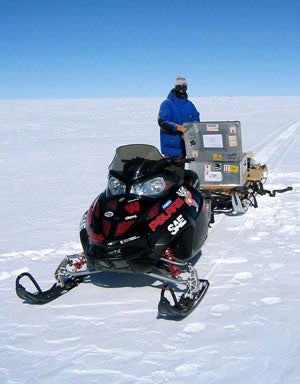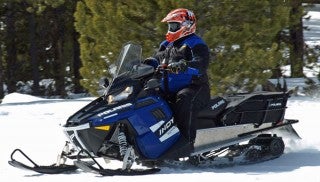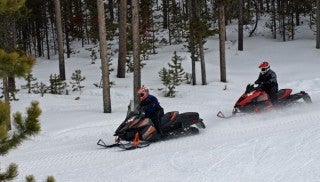Alternative Power for Snowmobiles

Honing ideas for new propulsion systems
The Tesla electric sports car is a vehicle that makes some news reporters seemingly forget about objectivity. They get behind the wheel, and suddenly hoots and hollers come through the remote mike.
The performance-oriented, lithium-ion battery powered sports car may go from zero to 60 mph in four seconds, but can its technology segue into the snowmobile market?
Yes…and no, says Jay Meldrum, director of the Keweenaw Research Center in Houghton, Mich. Electric snowmobiles are possible, but current technology won’t make a machine that performs to the typical snowmobilers’ standards, he says. However, there are other alternatives that could be possible for future snowmobile applications. In addition to electricity, a gas-electric hybrid and a flex-fuel snowmobile could also be potential power sources for the snowmobile.
The Electric Snowmobile
Tesla is to cars what the Bucky EV is to snowmobiles. The Bucky EV may not have the suave-sounding appeal of a name like Tesla, but it’s made a big impression.
It debuted at the Clean Snowmobile Challenge (CSC) in 2008 as a project sled from the University of Wisconsin, Madison. It was shipped to Greenland in the summer of 2008 as a zero-emissions vehicle for the National Science Foundation’s (NSF) research efforts. NSF was so impressed with the vehicle that it’s ordered more for its field fleet, says Glenn Bower, a scientist and faculty associate at the University of Wisconsin in Madison, and the advisor for Madison’s CSC team.
 Ethan Brodsky of the University of Wisconsin-Madison with the Bucky EV at an NSF arctic research station in Greenland.
Ethan Brodsky of the University of Wisconsin-Madison with the Bucky EV at an NSF arctic research station in Greenland.This was the third year for zero-emissions snowmobiles in the CSC, a collegiate design competition sponsored by the Society of Automotive Engineers. Meldrum, who also organizes the event, said he’s seen a gradual evolution of electric-only snowmobiles. One early machine had advanced power with lithium-ion batteries but weak electronics. Another machine used lead acid batteries and the sled weighed in at a half-ton. Now, student engineers are keen to high-tech lithium ion and nickel cadmium batteries and more advanced charging systems.
The major barriers to electric snowmobiles are energy storage and overall cost.
“There isn’t a technology available that will store enough energy in small enough packages to make a machine go very far,” Meldrum says.
The Bucky EV uses 84 28-volt Milwaukee Tool batteries — the same type that power a cordless drill. They are packaged in 12 banks of seven, and placed around the vehicle. With that, the machine can get up to 75 mph, but has a range of about 18 miles. By comparison, the Tesla uses more than 7,000 lithium ion batteries with an approximate 220-mile range.
Energy-sapping cold temperatures inhibit batter capacity, and batteries can have difficulty operating at variable speeds, Meldrum says.
Even with developments in the automotive world, battery-powered engine technology is prohibitively expensive for manufacturers and consumers, Bower says. High-performance battery packs are not yet mass-produced, which is why Bucky EV uses tool batteries.
Bower sees an electric snowmobile as a niche machine, with an electric engine in the same basic hull of a modern snowmobile.
“This is not a snowmobile you can take into the mountains for a day,” says Bower. “But this could be for someone in suburban Chicago with four acres of land who wants something quiet that their kids could drive. There could be applications in Scandinavia, in Europe or in our national parks.”
The Hybrid Snowmobile
There are mixed opinions on whether hybrid gas-electric technology would work in a snowmobile.
There are a couple different approaches, Bower said. There’s the ‘series’ engine where the vehicle uses electric propulsion. When the batteries lose enough juice, an onboard charging device recharges the batteries and/or supplies the power to the electric drive system. The charging device can be an engine/generator combo or a hydrogen fuel cell. The other option is ‘parallel’, which uses a small internal combustion engine and an electric motor. The electric motor supplements the power lost with the smaller combustion engine. The result is equivalent performance with increased fuel economy as the smaller engine will operate at a higher efficiency during constant-speed driving.
Bower says the Madison CSC team experimented with the first option: weight was a limiting factor and it needed some sort of power boost. Bower sees this as a better technology for ATVs.
Meldrum doesn’t think hybrids make sense for snowmobiles because there isn’t enough space for two engines under a snowmobile hood.
“There just doesn’t seem to be big-enough technology in a small-enough package to get the performance levels that snowmobilers want,” says Meldrum.
That doesn’t mean that others have not tried.
Provo, Utah-based Raser Techologies offered its own version of a hybrid electric snowmobile engine. The new engine used its proprietary Symetron technology and was a series hybrid: an electric engine drove the vehicle and an onboard generator recharged the lithium battery. The result was 80 horsepower and a claimed noise reduction of 618 times over the combustion version. The hybrid engine weighed an estimated 99 pounds.
The engine received some attention from the National Park Service and local Utah media, but never made it to the market place. The snowmobile project was abandoned in 2005 and Raser reapplied the technology to other vehicles, such as automobiles and industrial vehicles.
“There was bigger opportunity there,” says Richard Putnam, head of investor relations at Raser. “It’s still a viable technology for snowmobiles, but there was more opportunity in different applications.”
The technology is still available for license, Putnam says, should an engine-maker or manufacturer wish to pursue it. However, Putnam doesn’t see Raser doing its own continued development in the snowmobile market on its own.
The Flex-Fuel Snowmobile
The adaptation of current snowmobile engines to accept ethanol-blend fuels is likely the easiest form of alternative power.
Bower estimates that it would cost snowmobile manufacturers less than $200 per unit to make engines flex-fuel ready, not including engineering time. Modifications include different component compounds in the fuel system (E85 makes current compounds dissolve over time); larger holes in the fuel injectors (more fuel is needed to meet power needs) and engine re-mapping (the engine needs to sense the percentage of ethanol and adjust accordingly).
The challenge of bio-fuels is availability.
“We found that when we go snowmobiling, nobody carries E85 on the trails,” says Bower. “When we were in Michigan, we found only one service station that carried E85.”
However, the more common E10 blend could be used in a flex-fuel snowmobile, as well.
Non-liquid fuels — propane, fuel cells or hydrogen — are not practical, either, said Bower, and even diesel is a stretch.
“If you could get a diesel snowmobile started, it would be great for fuel efficiency,” says Bower, “but it would be difficult to get power out of it. You can’t spin at 8,000 to 10,000 rpm like a gasoline engine. You can only go about 5,000 to 5,500 rpm.” There are advanced diesel engines in Europe, such as the Smart Car, but then the cost of the snowmobile would double, Bower said.
This past year, Swedish high school students developed and tested a diesel-powered snowmobile. The students replaced the engine on an Arctic Cat Bearcat 660 with a Lombardini three-cylinder engine. It also got an electronic regulator from Pivario, a more powerful battery as well as other modifications. The resulting snowmobile averages 29 miles per gallon, but in ideal conditions got up to 53 miles per gallon. Hydrocarbon emissions were also very low. The improved fuel consumption does come with a price: the modified engine is 27 hp, the weight is up to 882 pounds, max torque is at 2,000 rpm, and its estimated cost would be double the standard two-stroke.
The students have more ideas for the next generation of the machine, including turbo, increased emission reduction and weight reduction.
Links: Video of Raser electric hybrid machine Video of Tesla Clean Snowmobile Challenge Bucky EV








 Your Privacy Choices
Your Privacy Choices